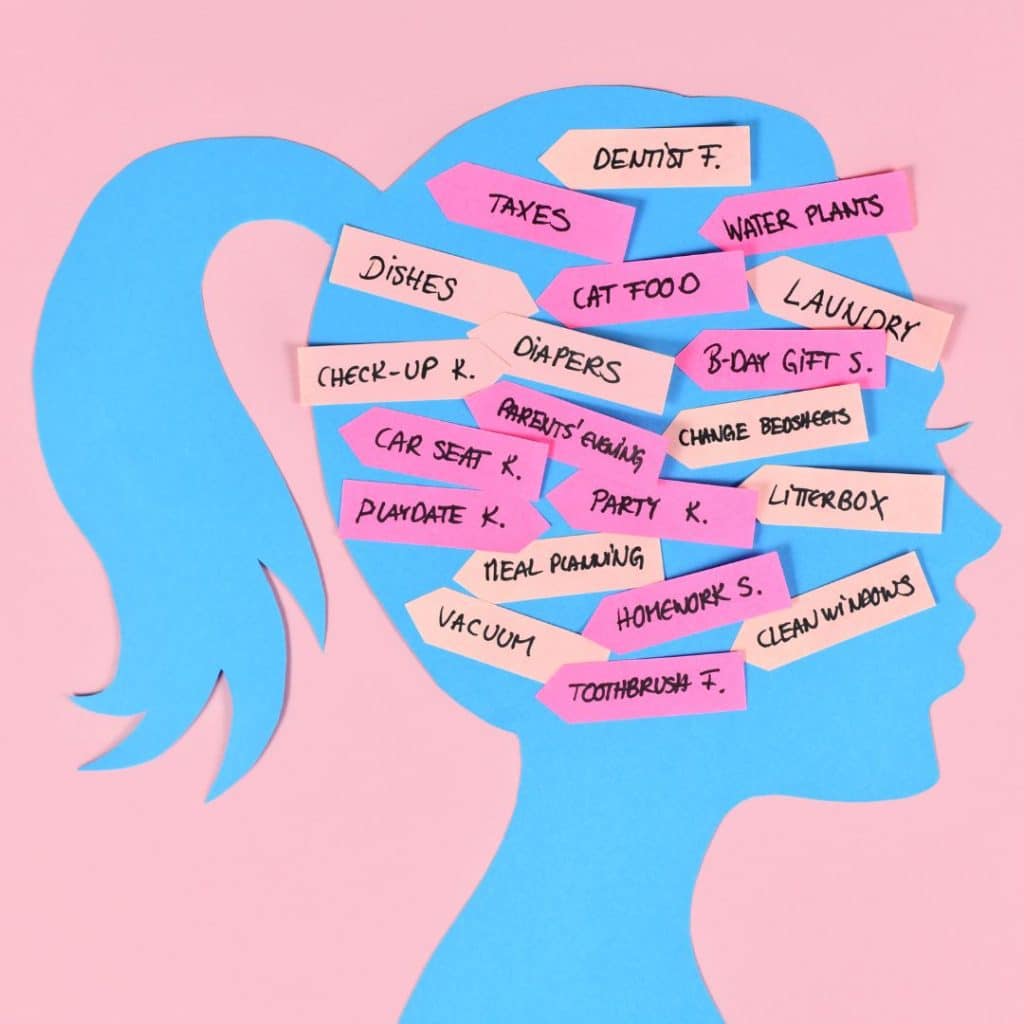Motherhood, often celebrated as one of life’s most beautiful journeys, comes with an unspoken burden – the mental load. It’s a responsibility, heavy and relentless, that many women carry silently, affecting their well-being and relationships.
The term, “mental load”, gained attention in 2017 through a viral feminist comic, and since then, it has been the subject of discussions, studies, and debates.
In this blog post, we’ll delve into the concept of the mental load, understand its origins, explore its impact, and discuss potential solutions. Our goal is to equip both women and men with the knowledge and inspiration to drive change for a brighter, more equitable future.
Defining Mental Load
The mental load is a term often discussed in the space of family dynamics, but its profound implications reach far beyond the home. This invisible load encompasses the emotional and mental labor, planning, and organization needed to maintain a household, family, and personal life.
While not exclusive to mothers, statistics reveal that women disproportionately bear the weight. According to the United Nations, women perform nearly twice (around 4 hours) as much time on unpaid work as men (usually 2.5 hours). This ongoing imbalance is a pressing issue demanding attention.
Significance of Exploring Mental Load in Women
The mental load is not just a household issue; it is a societal challenge. Unpacking its significance reveals the urgency of addressing it.
Women, the primary bearers of this burden, often struggle to strike a balance between personal, professional, and familial obligations. This relentless juggling act is emotionally and physically taxing, leading to burnout, strained relationships, and long-term health issues. For instance, mental load is one of the primary causes of depression which is twice as common in women compared to men.
The Origins and Evolution of Mental Load
Now, let’s dive into the historical roots of the mental load in women and its evolution over time.
Historical Context: Gender Roles and Responsibilities
Centuries ago, as far back as the 17th and 18th centuries, women were predominantly confined to the roles of homemakers and caregivers. Their daily lives were enveloped in relentless household and childcare responsibilities.
Fast forward to the 19th and early 20th centuries, and the constraints of these gender roles began to loosen slightly, yet women still carried the significant weight of household chores and childcare. The prevailing expectations, deeply ingrained in societal norms, left women to shoulder both the emotional and mental burden of daily life. These historical imprints have cast long shadows into the present day, influencing how we perceive and address the mental energy women have to expend.
Modern Shifts: Balancing Work, Family, and Personal Life
In the modern era, marked by the 21st century, women have made considerable advancements in the workplace. The tides of change began to surge in the mid-20th century, with the feminist movement and the second wave of feminism in the 1960s and 70s. This transformative period opened up new opportunities for women, enabling them to pursue careers, education, and professional aspirations.
However, as the 21st century unfolded, the mental loads did not dissipate. Instead, it adapted to the changing landscape. Women increasingly found themselves in the challenging position of balancing high-powered careers with the responsibilities of a bustling household.
This struggle has intensified in recent times, especially in the wake of the COVID-19 pandemic. A recent study reveals that a third of employed parents who have the same job as before the pandemic and have children under age 18 say that compared with before the outbreak, it has been harder to balance work and family responsibilities. Also, working moms are more likely than working dads to acknowledge the increased difficulty, with 39% of mothers expressing the added challenge, compared to 28% of fathers.
Factors Contributing to Mental Load in Women
Next, we’ll explore the various factors that contribute to the overwhelming mental load of women.
Societal Expectations and Norms
Society’s expectations often reinforce traditional gender roles, pushing women to excel both in their professional and domestic lives. While progress has been made, there remains a heavy burden on women to perform these roles, often leading to an emotional and mental toll. It’s a cycle that must be broken.
Unequal Division of Household and Caregiving Tasks
One of the most pressing issues contributing to the mental load is the unequal division of household duties and caregiving tasks. Women frequently find themselves shouldering the bulk of these responsibilities, from cooking and cleaning to managing their young kids. This unequal division perpetuates stress, emotional exhaustion, and relationship strains.
Career Aspirations and Professional Challenges
Many women aspire to excel in their careers, yet this ambition is often challenged by the weight of the mental load. Balancing a high-powered career with family responsibilities leads to immense pressure, potentially derailing career progression and causing emotional turmoil. Plus, according to Pew Research, besides their undergraduate major choices, women may encounter obstacles when entering high-paying occupations for various reasons. This is despite achieving parity in numerous advanced degree programs. A reason behind this challenge can also include differences in household and parenting responsibilities, alongside gender discrimination. Research from the Harvard Business Review highlights the challenges women face in maintaining their professional ambitions while managing the mental load.
Exploring the Impact on Women’s Well-being
Understanding the mental load in women is crucial, but what’s its impact on women’s well-being? Let’s delve into the emotional and physical toll it takes.
Stress, Anxiety, and Burnout
The constant juggling act that comes with the mental load takes a toll on women’s mental health. Stress and anxiety are common consequences, potentially leading to burnout. According to the World Health Organization, burnout is a significant threat to mental health. It’s a burden that affects women in multifaceted ways.
Emotional Toll and Relationship Dynamics
The mental work often strains relationships, leading to frustration, resentment, and emotional disconnection. The toll on women’s emotional well-being is palpable. Renowned relationship expert Dr. John Gottman emphasizes the importance of addressing these issues for the sake of healthy partnerships.
Health Implications: Physical and Mental
The stress induced by the mental load can lead to long-term health implications, affecting women’s physical and mental health. Chronic stress is linked to heart disease, diabetes, and mental health disorders. Addressing the mental load is not just about equality; it’s about safeguarding the health of women.
The Intersection of Cultural and Social Influences

Moving beyond individual experiences, how do cultural and social influences shape the perception of the mental load?
Cultural Variation in Mental Load
The mental load isn’t a one-size-fits-all concept; it varies significantly across cultures due to the influence of societal expectations and values. In some cultures, there may be a more equitable distribution of domestic responsibilities, while in others, traditional gender roles persist. Statistics from the World Economic Forum show that countries like Sweden, Norway, and Iceland have made substantial progress in reducing the gender gap in household chores, while countries like India and Saudi Arabia still struggle with a stark imbalance.
Media’s Role in Shaping Perceptions and Expectations
Media has an undeniably influential role in shaping our perceptions and expectations regarding motherhood and gender roles. The portrayal of women in the media often reinforces traditional stereotypes, which can be detrimental to the progress of gender equality. Research conducted by the Geena Davis Institute on Gender in Media revealed that in family films, there is only one female character for every three male characters, reinforcing gender imbalances.
Media outlets must shift their narrative and better represent the evolving roles and responsibilities of women in society. Prominent public figures and organizations, like Emma Watson’s “HeForShe” campaign and the #SeeHer movement, have been advocating for more inclusive and empowering representations of women in the media. By showcasing women who balance careers, family, and self-care, the media can encourage a broader acceptance of diverse gender roles.
For example, television shows and advertisements featuring men actively participating in domestic responsibilities send a powerful message that challenges traditional gender norms. These positive portrayals help normalize shared responsibilities and promote the idea that caregiving and household tasks are not confined to any one gender.
Navigating Relationships: Partner Dynamics
The burden of the mental load often reaches its zenith within the intimate confines of relationships. It’s here that effective communication and a shift towards equal partnerships can make a world of difference.
Communication Patterns
Open and honest communication is the cornerstone of addressing the mental load within relationships. Partners must create an environment where they can engage in candid discussions about their roles, responsibilities, emotions, and even parenting styles. This open dialogue allows them to understand each other’s experiences better and find collaborative solutions to distribute the burden more equally.
To facilitate effective communication, couples can establish regular check-ins or “family meetings” where they openly discuss their responsibilities, identify areas of imbalance, and brainstorm strategies to create more equitable arrangements. This practice can lead to a better understanding of each partner’s strengths and preferences, which can inform task allocation.
Shifting Toward Equal Partnerships
Moving towards equal partnerships is essential for addressing the mental load in women. It necessitates both partners actively participating in domestic responsibilities and emotional and cognitive labor. Gender equality and shared responsibilities should be the norm, not the exception. In such partnerships, tasks are divided based on individual strengths, preferences, and availability, rather than predetermined gender roles.
To help this shift, innovative tools like the Maple app provide a valuable solution. Maple serves as a collaborative platform for partners to seamlessly delegate and organize household tasks. By streamlining communication and task management, Maple empowers couples to distribute responsibilities more equitably, fostering a more balanced and harmonious partnership.
Here are a few additional strategies to help couples shift toward equal partnerships:
- Shared Responsibility: Both partners should acknowledge the importance of shared responsibility and agree to contribute equally to domestic tasks. This involves a mutual commitment to address imbalances.
- Task Delegation: Partners can take on tasks that they excel at or enjoy, and they can delegate or share other responsibilities as necessary. For example, one partner might handle cooking while the other manages finances.
- Equal Emotional Labor: Emotional labor, such as remembering important dates, can also be shared. Creating shared calendars and to-do lists can help distribute this responsibility more evenly.
- Flexibility: Recognize that life is dynamic, and there will be times when one partner may need to take on more due to work commitments or personal reasons. The key is a mutual understanding and willingness to support each other when needed.
- Regular Check-Ins: Schedule regular check-ins to assess the distribution of tasks and adjust as necessary. These discussions should include emotional aspects as well, addressing any stress or burnout either partner may be experiencing.
- Supportive Environment: Both partners should actively support each other in their endeavors, whether it’s career advancement or personal growth. Encourage and celebrate each other’s successes and provide emotional support during challenging times.
Motherhood and Mental Load
The mental load for mothers is a multifaceted responsibility that extends beyond the daily chores. It encompasses the emotional labor, organizational duties, and constant thinking required to prevent a messy house while simultaneously tending to children.
Prevalence of Mental Load Among Mothers
With heterosexual couples, a significant majority of mothers bear the brunt of the mental load. According to a study by the Pew Research Center, a staggering 86% of mothers with children under the age of 18 report feeling rushed in their daily lives. This feeling of being constantly hurried is a testament to the unceasing demands mothers face, which often lead to heightened stress levels and emotional exhaustion. It’s a clear indication that the mental load is a pervasive issue, transcending borders and cultures.
Balancing Childcare, Work, and Self-care
The challenge for mothers goes beyond the relentless pace of their daily lives. Balancing childcare, work, and self-care becomes an intricate, demanding puzzle. This struggle underscores the importance of recognizing and addressing the mental load. Mothers must prioritize their well-being, as a burned-out, stressed mother is not in the best position to care for her children and excel in her career.
Working with a nanny placement agency such as Hello, Nanny! can be a transformative step in addressing the mental load. These agencies specialize in matching families with skilled nannies who can provide much-needed support. A nanny can take on childcare responsibilities, allowing mothers to focus on their work and personal care without sacrificing the quality of their children’s care. This assistance can be a game-changer, reducing the mental load and giving mothers the time and freedom they need to find balance.
Partner With Hello, Nanny! And Lighten Your Mental Load Today!
Workplace Challenges and Expectations
Navigating the world of work while shouldering the responsibilities of a household is a daunting feat for many working mothers.
Double Shift: Work and Household Responsibilities
The term “double shift” embodies the reality faced by countless working mothers. They not only engage in demanding careers but also bear the lion’s share of household responsibilities, including childcare and domestic tasks. This exhausting juggle often occurs without adequate support or assistance.
In the United States, particularly in California, where the cost of living is notably high, this challenge is exacerbated. As one of the most progressive states in the country, California offers some policies to alleviate the mental load on working mothers. The California Family Rights Act (CFRA) and the Paid Family Leave (PFL) program provide job-protected leave and partial wage replacement for eligible employees who need time off to care for a seriously ill family member or bond with a new child. If the mother is pregnant, the Pregnant Workers Fairness Act (PWFA) 2023 protects the rights of pregnant workers and prevents discrimination during pregnancy. It mandates reasonable accommodations for pregnant employees, ensuring that they can continue to perform their job responsibilities safely and without undue stress.
However, despite these progressive policies, many working mothers still struggle with the double shift, highlighting the need for further improvements in workplace policies.
Breaking Glass Ceilings while Balancing Mental Load
The concept of the “glass ceiling” refers to an invisible barrier that hinders the advancement of women, preventing them from reaching top-level positions in their careers. The term was coined in the late 20th century, and it signifies the persistent gender disparities in the workforce.
Women are often caught between their aspirations for professional success and the burden of the mental load. However, Sheryl Sandberg, Facebook’s ex-COO and current board member, has been an advocate for empowering women to shatter this glass ceiling. She encourages companies to create environments that enable women to excel without the added burden of managing the bulk of domestic responsibilities.
Companies can foster this empowerment by offering flexible work arrangements, mentorship programs, and leadership training to help women reach their full potential while maintaining a balanced life.
The Role of Policy and Society
Advocacy for equal parental leave and benefits plays a pivotal role in addressing the mental load. Policy changes are essential to encourage fathers to take an active role in caregiving, ensuring that responsibilities are more equitably distributed.
In California, the state has taken significant strides in this regard. The California Paid Family Leave program provides wage replacement benefits to eligible workers who need time off to bond with a new child or care for a seriously ill family member. Encouragingly, California’s policies have set a precedent for other states in the U.S., signaling a move towards greater gender equality and shared responsibilities within households.
Corporate Policies Promoting Work-Life Balance
Companies also bear a significant responsibility in lightening the mental load of working mothers. Corporate policies that promote work-life balance are essential. These policies should include flexible working hours, remote work options, and supportive environments that allow mothers to excel in their careers while maintaining a healthy family life.
Shifting Norms: Education and Awareness
Open discussions, education, and awareness campaigns are vital tools for helping people recognize and address this issue. For instance, breaking the cycle of the mental load begins with early education and parenting. Prominent educator and author Bell Hooks emphasizes the role of education in promoting equality. Teaching children about equality and respect from a young age is a vital step in reshaping societal norms. By fostering these values in future generations, we can create a world where shared responsibilities and equitable partnerships are the norm.
Tools and Coping Mechanisms
As we explore the complexities of the mental load, we must equip ourselves with the right tools and coping mechanisms to manage the multifaceted responsibilities effectively.
Effective Time Management Strategies
One of the fundamental pillars in addressing the mental workload is efficient time management. By optimizing how you use your time, you can alleviate stress, enhance productivity, and create a more balanced life. Here are some strategies and tools for effective time management:
- Prioritization: Begin by identifying your most important tasks and priorities. Tools like the Eisenhower Matrix can help you categorize tasks into four quadrants based on their urgency and importance, allowing you to focus on what truly matters.
- Time Blocking: Allocate specific blocks of time for different tasks, whether it’s work, childcare, or personal activities. Tools like digital calendars, such as Google Calendar or physical planners, can help you visualize your day and allocate time accordingly.
- To-Do Lists: Create daily or weekly to-do lists to organize your tasks. Tools like digital task management apps (e.g., Todoist, Asana) or traditional pen-and-paper lists can help with keeping track of your responsibilities.
- Batching: Group similar tasks together and complete them in one go. For instance, designate a specific time for responding to emails, handling all the chores, or working on projects. This minimizes context-switching and boosts efficiency.
- Time Tracking: Use time-tracking apps like Toggl or Clockify to monitor how you spend your time. This can provide insights into areas where you may be overcommitting or where time is underutilized.
- Setting Boundaries: Clearly define your work hours, personal time, and downtime. Communicate these boundaries to your family, colleagues, and friends to ensure you have the space you need to focus on various responsibilities.
elegating Tasks and Seeking Support
Delegating tasks and seeking support is another pivotal aspect of managing the mental load. No one should carry this burden alone, and working with a nanny can be a solution to lighten the load.
A nanny is a trained professional who specializes in providing child care and often offers valuable support in household tasks. By enlisting the help of a nanny, you can achieve the following benefits:
- Childcare: A nanny can take on childcare responsibilities, ensuring your children receive quality care, educational stimulation, and emotional support.
- Household Tasks: Nannies/household managers are often skilled in performing household tasks, such as cooking, cleaning, and laundry. This support can free you from the constant demands of domestic responsibilities.
- Flexible Schedules: Nannies can adapt to your specific needs, offering support during working hours, evenings, or weekends, depending on your requirements.
- Personal Time: With a nanny handling childcare and household tasks, you gain precious personal time. This time can be used for work, self-care, pursuing personal interests, or simply enjoying moments of relaxation.
- Reduced Stress: By sharing the responsibilities with a nanny, you can significantly reduce stress and the emotional toll that often accompanies the mental load.
Working with a nanny placement agency such as Hello, Nanny! can be the answer you need. We specialize in matching families with experienced nannies who are well-equipped to support mothers in managing their roles effectively. Hello, Nanny! can connect you with a nanny who aligns with your family’s needs, ensuring that you receive the support required to alleviate the mental space.
Partner With Hello, Nanny! And Lighten Your Mental Load Today!
Summary of Key Points
The mental load is a significant issue that affects women’s well-being, relationships, and overall quality of life. It has deep-rooted historical and cultural origins, but with awareness, communication, and policy changes, we can alleviate this burden.
By challenging traditional gender roles, promoting equality, and educating future generations, we can create a more equitable and nurturing world for all.
It’s time to share the load and empower women to thrive in every aspect of life.
As activist Gloria Steinem famously said, “The story of women’s struggle for equality belongs to no single feminist nor to any one organization but to the collective efforts of all who care about human rights.”
It’s time to share that burden collectively and usher in a more equal, compassionate world.
Partner With Hello, Nanny! And Lighten Your Mental Load Today!











